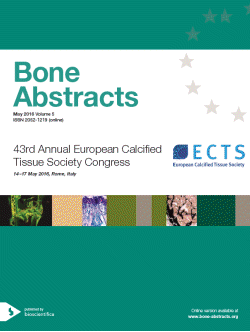
43rd Annual European Calcified Tissue Society Congress
Rome,
Italy
14 May 2016 - 17 May 2016

New Investigator Oral Communications
Abstract Presentations
ba0005ni1 | Abstract Presentations | ECTS2016
Rictor plays a critical role in bone mass and strength with the involvement of Mtorc2 pathway in osteoblasts
Liu Dong-mei , Zhao Lin , Liu Ting-ting , Jiao Pei-lin , Zhao Dian-dian , Shi Mei-Shu , Tao Bei , Sun Li-hao , Zhao Hong-Yan , Liu Jian-min
ba0005ni2 | Abstract Presentations | ECTS2016
Circulating microRNAs in postmenopausal women with osteoporosis and vertebral fractures
Yavropoulou Maria , Anastasilakis Athanasios , Makras Polizois , Grammatiki Maria , Kotsa Kalliopi , Yovos John
ba0005ni3 | Abstract Presentations | ECTS2016
Tumor necrosis factor superfamily members in bone loss in men with end-stage chronic obstructive lung disease
Kochetkova Evgenia , Ugay Ludmila , Maistrovskaia Yuliya
ba0005ni4 | Abstract Presentations | ECTS2016
The correlation between number and population of bone marrow endothelial progenitor cells with bone mass and bone metabolism in the elderly
Cheng Qun , Lin Shangjin , Bi Bo , Fan Yongqian , Lin Weilong
ba0005ni5 | Abstract Presentations | ECTS2016
Altered bone metabolism after high fat diet and exercise: role of Wnt signaling and insulin resistance
Picke Ann-Kristin , Sylow Lykke , Moller Lisbeth L V , Kjobsted Rasmus , Richter Erik , Rauner Martina , Hofbauer Christine , Hofbauer Lorenz C
ba0005ni6 | Abstract Presentations | ECTS2016
Multi-potency and immunosuppressive activity of mesenchymal stromal cells derived from human induced pluripotent stem cells
Roux Clemence , Saviane Gaelle , Pini Jonathan , Dihib Gihen , Nourhene Belhaid , Wakkach Abdel , Blin-Wakkach Claudine , Rouleau Matthieu
ba0005ni7 | Abstract Presentations | ECTS2016
Exposure to chronic stress induces bone loss via glucocorticoid signalling in osteoblasts
Henneicke Holger , Li Jing-Bao , Gasparini Sylvia J , Seibel Markus J , Zhou Hong
ba0005ni8 | Abstract Presentations | ECTS2016
Bone marrow adipose tissue and bone turnover in postmenopausal osteoporotic women and the effects of raloxifene
Beekman Kerensa , Heijer Martin den , Maas Mario , Bisschop Peter , Bravenboer Nathalie
ba0005ni9 | Abstract Presentations | ECTS2016
Inflammatory conditions induces a new subset of osteoclasts that prime TNFα-producing CD4+ T cells
Ibanez Lidia , Abou-Ezzi Grazia , Ciucci Thomas , Amiot Vanessa , Mansour Anna , Roleau Matthieu , Wakkach Abdelilah , Blin-Wakkach Claudine



